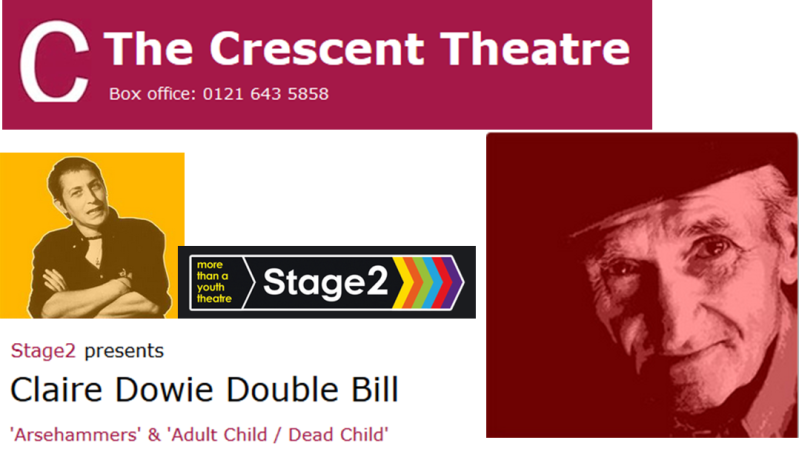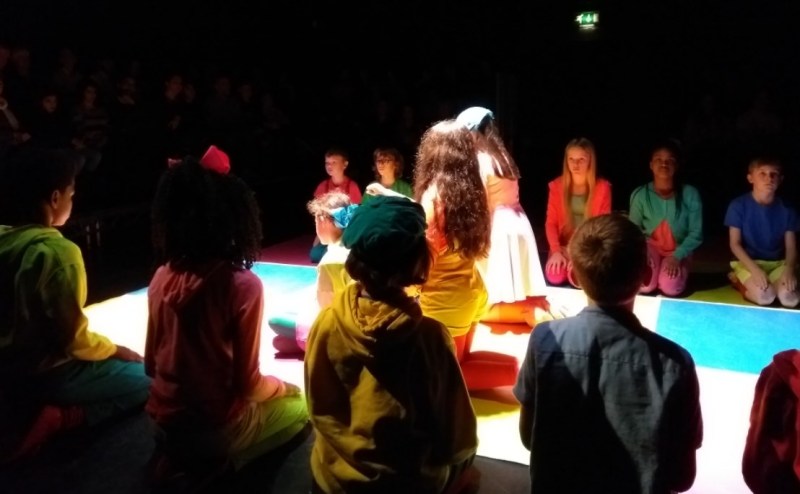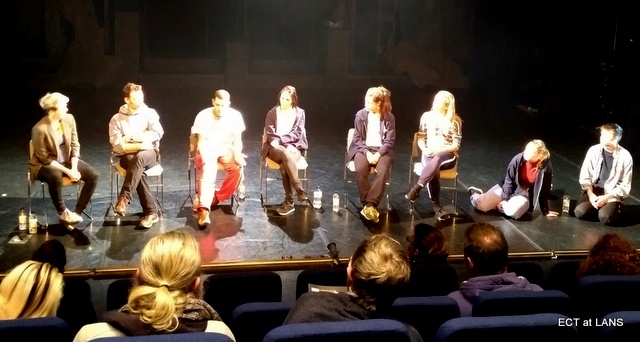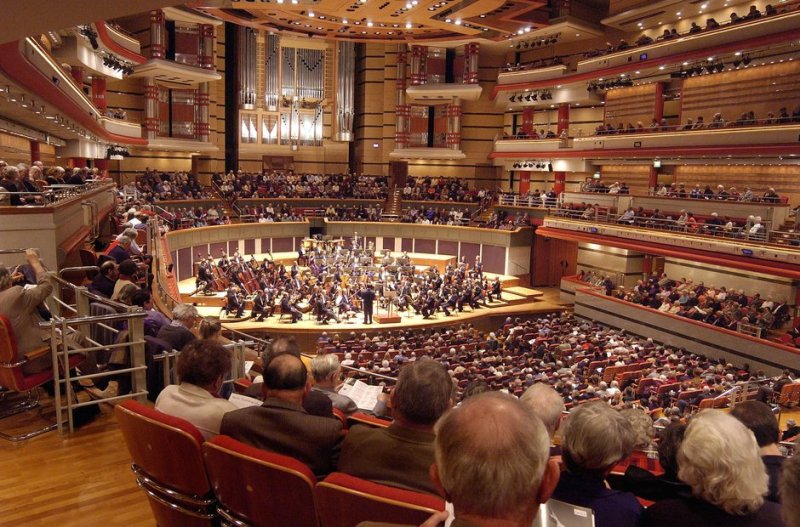An early January event – going to Crescent Theatre, that company of amateur theatre, run by volunteers but feeling quite professional, to see a production of two of Claire Dowie’s famouos monologues, staged by an incredible youth theatre company, Stage 2, founded in 1988 by Liz Light.

You walk in … and are overwhelmed by a sense of nostalgia; you see a group of kids playing a distoreted version of snakes and ladders with a die half their size and a splatter of childish glee across their faces. The audience is seated all around the room, as if encasing the children, centre-stage. The lights are bright and colorful, cheerful, much like the kids’ demeanour. They’re all dressed in overly bright shades of red, blue, and yellow; radiant and whimsical.
 The repetitive counting as they move their allotted steps adds a sort of ominous feel to the setting, as if this childish whimsy won’t last. The lights eventually dim, and there’s silence; darkness.
The repetitive counting as they move their allotted steps adds a sort of ominous feel to the setting, as if this childish whimsy won’t last. The lights eventually dim, and there’s silence; darkness.
The kids appear centre-stage, spot-lit, each with a toy-like prop and an exaggerated excited grin; they’re all engaged in play, happily oblivious, until they start speaking. They talk of a grandma gone to live with the angels, of a granddad who’s alone and might come to live with them. There’s excitement and wonder about them, but also sadness; as each kid speaks a bit of the narrative, they sit down, as if resigned, and continue to play with their props in a more subdued manner.
The lights dim once more and explode into sudden brightness, mayhem, and laughter. There’s sudden, projectile noise: protests to being fed false stories about angels and death. The monologue evolves into vivid dark imagery and angry tones, talking of death and claiming to be more mature. The music and the lights seem to follow the tune of the monologue, rising in pitch and brightness, until it reaches a crescendo and then falls, the lights slowly dimming and the excitement dwindling, as if the children were crashing after a sugar high.
Silence and darkness descend once more, and then they’re spot-lit; four of them are centre-stage with the rest lined at the back, each holding fast onto their toys. It’s a slow progression from then, they all slowly move to the centre, forming a V-shaped gathering; they talk in slow, eerily synchronized tones, of how granddad had gone out and not come back, of how the parents had been worried and out searching, leaving the kids at home, upset, confused, and angry. The dialogue is simple, but packed with emotional reverence, it leaves you feeling sympathetic, and oddly apologetic, longing to reach out and hug the hurting children.
 The tone shifts once more, the performers easily breaking into five groups, all engaged in excited play. It’s reminiscent of the fickle nature of childish thought and fixation, how easily they can go from angry and reserved to excited and animated.
The tone shifts once more, the performers easily breaking into five groups, all engaged in excited play. It’s reminiscent of the fickle nature of childish thought and fixation, how easily they can go from angry and reserved to excited and animated.
The music, having picked up once more as the kids began to play, eventually fades, and they’re all still, as if in a game of dancing freeze, but they break away slowly, exaggeratedly, moving around the room with grand gestures and overly enunciated talk of the war. In a brilliant display of production, the childish speculation and mayhem about granddad’s exciting adventures to weird and wonderful lands is juxtaposed by loud short bursts of music, as if telling of war times, but subtly; hinting at the real reason for granddad’s spontaneous disappearances, as opposed to the gleeful speculation of super powers.
They envisioned a dance they imagined he would always do before venturing out on one of his adventures, a silly little thing with an equally silly chant, but one they tried to copy one too many times, only to burst into giggles or disappointed sighs, wishing and hoping they would once more go back to playing hide and seek with granddad, instead of him always hiding away, leaving them alone, with a little sister too immature to entertain and a mother too frustrated to fully connect with.
The atmosphere slowly shifts again, its more solemn, more tense; granddad’s not with them, or so the parents say, but he seems perfectly alright, seated on his armchair with his binoculars slung around his neck, only he doesn’t talk or play, just stares ahead into a void, scaring and worrying the kids. They all pile into a car shortly after, being told by mum and dad they’re visiting granddad’s new home. It’s not quite clear why he couldn’t just stay with them, but they weren’t sure they wanted him around either, not if he wouldn’t play with them, so the journey was spent in confused sulking.

The desolate mood dissipated once they arrived at granddad’s new home; it had nurses and doctors in fancy clothes, and many other grandmas and granddads. They asked a reception lady that smelled a tad funny about this new place they’d be running up and down and all around in, and she told them granddad would be working with experts, lighting a new fire in their little tummies. He would be working with experts, with cool gadgets and machines, and saving the world all the other grandparents. The kids were beyond happy, even proud.
Only, mum was crying in the car on the way back, and they had to pretend not to notice because dad was driving on as if he didn’t notice, but it became harder and harder to ignore her tears and her sniffles the louder they got and the longer they continued. You could never contain curiosity for long, and so they asked, and mum told them granddad would not be coming back, that he was very sick, and they had to leave him there.
Alzheimer’s! The word resonated with the kids, because they’d been chanting ‘Arsehammers’ to themselves for a while, believing it to be granddad’s secret trick for traveling, but no, he was only sick. The mood dims and dulls further, as does the light, to show the dawning night. It was hard to fall asleep that night because it was hard to not think of granddad and all they’d believed so far, but eventually sleep came.
So did granddad, jolting them awake with a loud bang and a crash, as he performed the silly dance, loudly exclaimed ‘arsehammers’ and vanished. The next morning was frightful and full of tears as mum told the kids granddad was dead, but their little hearts held onto the fantasy – he was only at home with grandma and the angels – as they silently played with their toys; a sharp contrast to the cheery attitude at the start.
Contributed by Arooba Shami, Year 1 LANS
pictures by E.C. Toescu
 The six dances showcased an impressive range of style and skill from the performers. The show opened with the Act III pas-de-deux from The Sleeping Beauty, a classical piece requiring a perfectly executed balance of strength and grace. This was contrasted with others, such as the far more contemporary After the Rain: pas-de-deux and the comedic La Fille mal Gardée clog dance, an entertaining fusion of ballet and tap performed in (you guessed it) clogs. My personal favourite was the finale: pas-de-deux and solos from Don Quixote. It was a fiery and exciting dance with many leaps and jumps culminating in a series of seemingly never-ending spins from the ballerina.
The six dances showcased an impressive range of style and skill from the performers. The show opened with the Act III pas-de-deux from The Sleeping Beauty, a classical piece requiring a perfectly executed balance of strength and grace. This was contrasted with others, such as the far more contemporary After the Rain: pas-de-deux and the comedic La Fille mal Gardée clog dance, an entertaining fusion of ballet and tap performed in (you guessed it) clogs. My personal favourite was the finale: pas-de-deux and solos from Don Quixote. It was a fiery and exciting dance with many leaps and jumps culminating in a series of seemingly never-ending spins from the ballerina. This concert was also of significance as it was the second to last performance of principal dancer Iain Mackay, who has been with the Birmingham Royal Ballet for 19 years. He and his partner, Jenna Roberts, danced After the Rain and Spartacus: adagio of Spartacus and Phrygia. According to the Birmingham Royal Ballet’s website “Iain created the role of the Prince in David Bintley’s Cinderella which premiered in 2010 and was broadcast on BBC Two to millions of viewers on Christmas Day that same year. He is also known for his outstanding performances as Romeo in Romeo and Juliet, the Third Seminarian in Carmina Burana and most recently for creating Prospero in David Bintley’s 2016 production of The Tempest.”1 He took his bow here to a standing ovation and huge round of applause.
This concert was also of significance as it was the second to last performance of principal dancer Iain Mackay, who has been with the Birmingham Royal Ballet for 19 years. He and his partner, Jenna Roberts, danced After the Rain and Spartacus: adagio of Spartacus and Phrygia. According to the Birmingham Royal Ballet’s website “Iain created the role of the Prince in David Bintley’s Cinderella which premiered in 2010 and was broadcast on BBC Two to millions of viewers on Christmas Day that same year. He is also known for his outstanding performances as Romeo in Romeo and Juliet, the Third Seminarian in Carmina Burana and most recently for creating Prospero in David Bintley’s 2016 production of The Tempest.”1 He took his bow here to a standing ovation and huge round of applause.




 The repetitive counting as they move their allotted steps adds a sort of ominous feel to the setting, as if this childish whimsy won’t last. The lights eventually dim, and there’s silence; darkness.
The repetitive counting as they move their allotted steps adds a sort of ominous feel to the setting, as if this childish whimsy won’t last. The lights eventually dim, and there’s silence; darkness. The tone shifts once more, the performers easily breaking into five groups, all engaged in excited play. It’s reminiscent of the fickle nature of childish thought and fixation, how easily they can go from angry and reserved to excited and animated.
The tone shifts once more, the performers easily breaking into five groups, all engaged in excited play. It’s reminiscent of the fickle nature of childish thought and fixation, how easily they can go from angry and reserved to excited and animated.

 On Wed 7th Feb 2018, the Symphony Hall housed another
On Wed 7th Feb 2018, the Symphony Hall housed another 